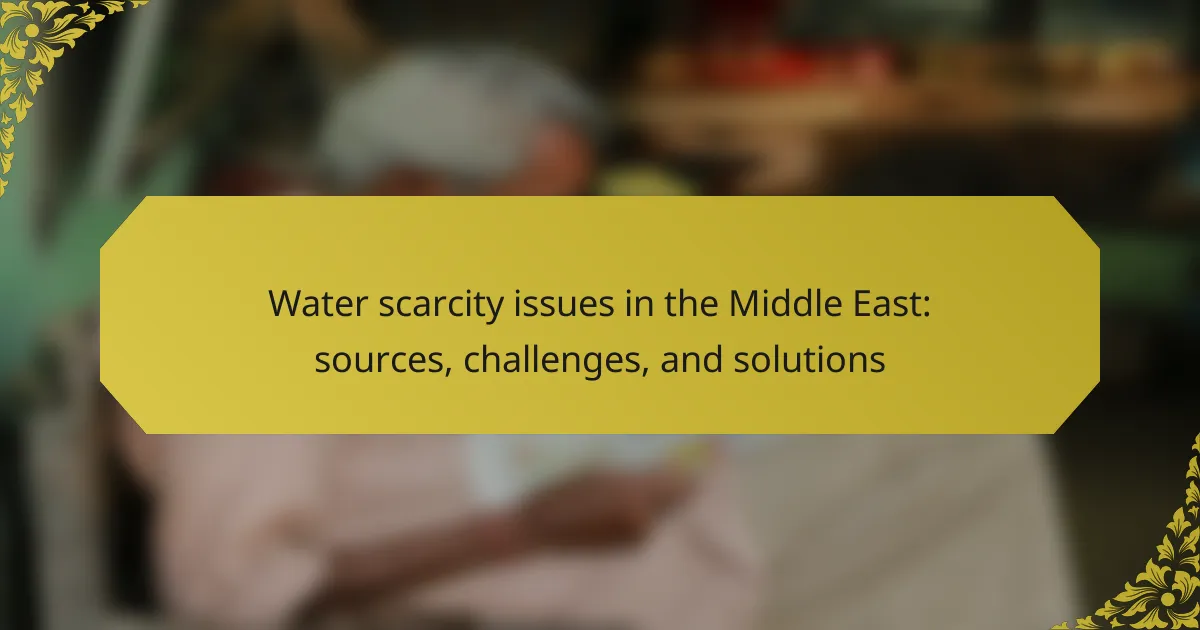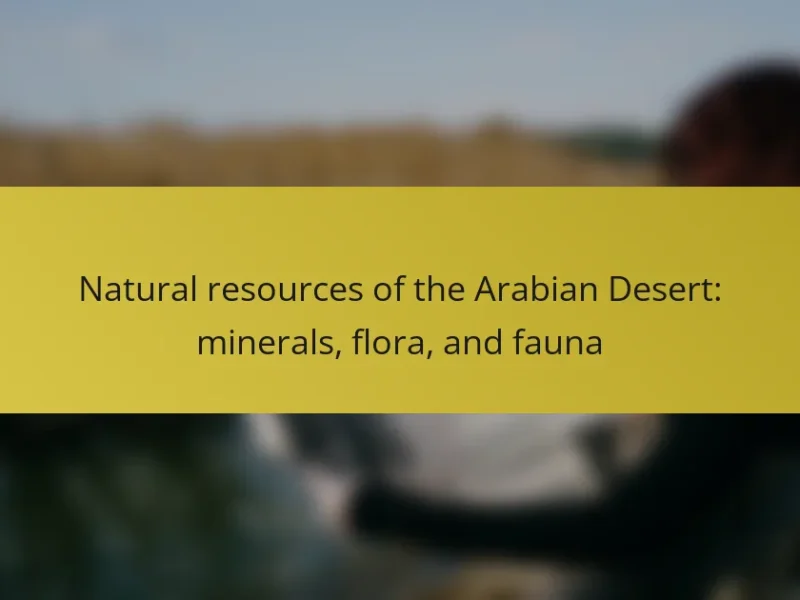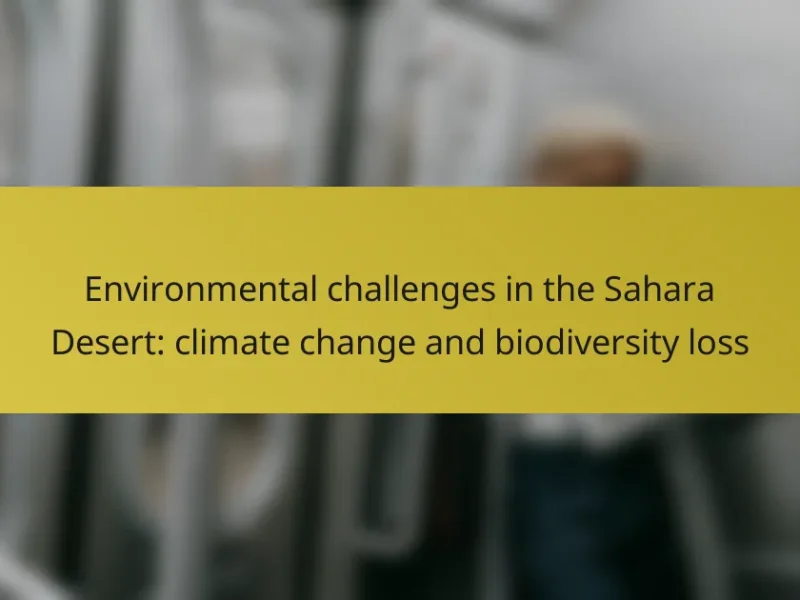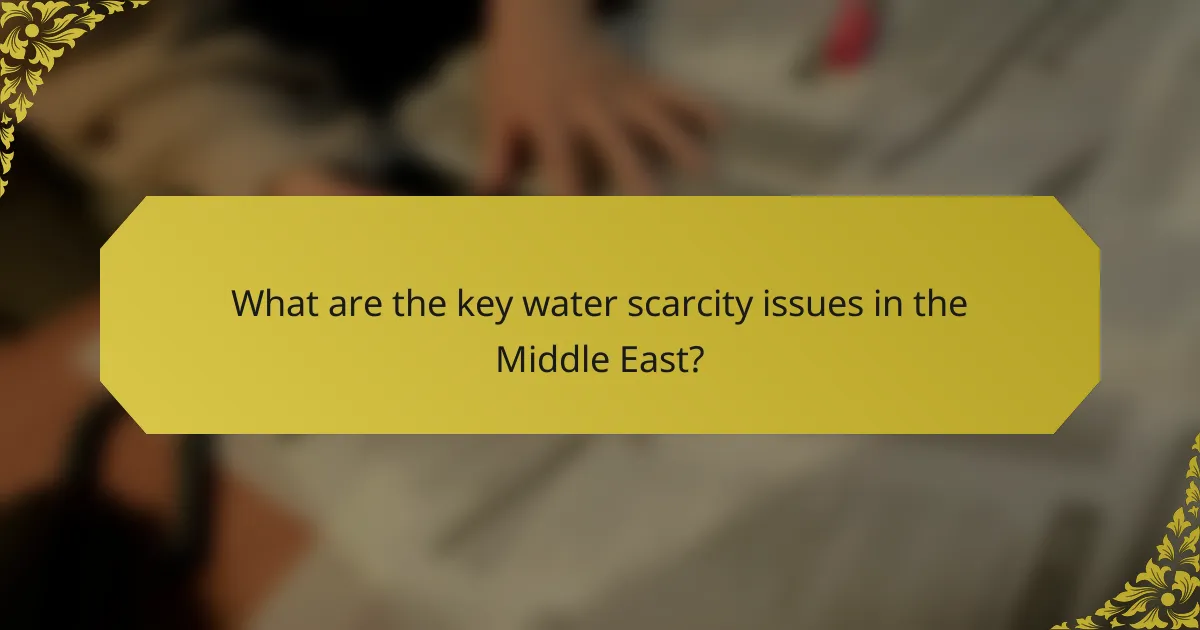
What are the key water scarcity issues in the Middle East?
Key water scarcity issues in the Middle East include over-extraction of water resources, climate change, and population growth. Over-extraction occurs due to unsustainable agricultural practices and urban demands. Climate change exacerbates water scarcity by altering precipitation patterns and increasing evaporation rates. Population growth leads to higher water consumption and increased competition for limited resources. The region has the lowest freshwater availability per capita globally, with some countries facing severe water stress. For example, the World Bank reports that water availability in the region has decreased by 30% over the past few decades. These factors collectively threaten food security and economic stability in the Middle East.
How does the geographical landscape contribute to water scarcity?
The geographical landscape significantly contributes to water scarcity. Arid and semi-arid regions, common in the Middle East, receive low annual precipitation. Mountain ranges can block moisture-laden winds, creating rain shadows that limit rainfall. Additionally, the topography can affect the distribution of water resources. River systems may not flow through densely populated areas, leading to uneven water availability. Soil types also play a role; sandy soils have high permeability, which results in rapid water loss. Urbanization often exacerbates these issues by increasing demand while decreasing natural water recharge. Historical data shows that many Middle Eastern countries face severe water shortages due to these geographical factors.
What are the main geographical features affecting water availability?
The main geographical features affecting water availability include mountains, deserts, and river systems. Mountains can block moisture-laden winds, creating rain shadows that reduce precipitation on the leeward side. Deserts, prevalent in the Middle East, have low rainfall and high evaporation rates, exacerbating water scarcity. River systems, such as the Tigris and Euphrates, are critical sources of freshwater but are often over-extracted for agricultural and urban use. The uneven distribution of these features leads to significant regional disparities in water availability.
How do climate conditions exacerbate water scarcity in this region?
Climate conditions significantly exacerbate water scarcity in the Middle East. High temperatures increase evaporation rates from water bodies. Limited rainfall contributes to reduced water availability. Droughts, which are becoming more frequent, further diminish water supplies. Climate change is projected to worsen these conditions, leading to more severe and prolonged dry spells. Additionally, changing weather patterns disrupt traditional rainfall seasons, making water management more challenging. As a result, agricultural productivity declines, straining already limited water resources. The combination of these factors creates a critical situation for water scarcity in the region.
What are the primary causes of water scarcity in the Middle East?
The primary causes of water scarcity in the Middle East include arid climate, population growth, and mismanagement of water resources. The region experiences low annual rainfall, averaging less than 250 mm in many areas. Rapid population growth increases water demand, straining available resources. Agriculture consumes about 85% of water in the region, often using inefficient irrigation techniques. Political conflicts disrupt water management and distribution. Additionally, over-extraction of groundwater depletes aquifers faster than they can be replenished. These factors collectively contribute to severe water scarcity in the Middle East.
How do population growth and urbanization impact water resources?
Population growth and urbanization significantly strain water resources. Increased population leads to higher water demand for domestic, agricultural, and industrial use. Urbanization concentrates this demand in cities, where infrastructure may be inadequate. According to the United Nations, urban areas consume about 80% of global water supply. Rapid urban growth often results in pollution of local water sources. Additionally, groundwater depletion occurs as cities expand, leading to long-term scarcity. In the Middle East, where water is already limited, these factors exacerbate existing challenges. Studies indicate that by 2025, some regions may face severe water shortages due to these pressures.
What role does agriculture play in water consumption and scarcity?
Agriculture is a significant contributor to water consumption and scarcity. It accounts for approximately 70% of global freshwater use. In the Middle East, this percentage can be even higher due to arid climates. Inefficient irrigation practices exacerbate water scarcity issues. Traditional methods often lead to substantial water loss through evaporation and runoff. Crop selection also impacts water usage. High-water-demand crops strain limited resources. Climate change further intensifies these challenges by altering precipitation patterns. As a result, agriculture’s role in water consumption directly influences water scarcity in the region.
What are the social and economic implications of water scarcity?
Water scarcity has significant social and economic implications. It leads to increased competition for limited resources. This competition can cause social unrest and conflict among communities. Water scarcity also affects agricultural productivity. Reduced crop yields can lead to food insecurity. Economically, it hampers industrial growth due to limited water supply. Countries facing water scarcity often experience increased costs for water sourcing and treatment. According to the World Bank, water scarcity can reduce GDP by up to 6% in some regions. Additionally, access to clean water is essential for public health. Water scarcity can lead to health crises, increasing healthcare costs and burdening economies.
How does water scarcity affect public health and sanitation?
Water scarcity significantly impacts public health and sanitation. Limited access to clean water leads to increased transmission of waterborne diseases. Conditions such as cholera and dysentery thrive in areas with inadequate sanitation. According to the World Health Organization, approximately 2 billion people lack safe drinking water. This situation exacerbates malnutrition and impairs immune function. Additionally, water scarcity can hinder proper hygiene practices. Insufficient water for handwashing increases the risk of infections. In the Middle East, regions facing severe drought report higher rates of illness. Thus, water scarcity poses a critical threat to community health and sanitation systems.
What economic challenges arise from limited water resources?
Limited water resources lead to significant economic challenges. Agriculture suffers due to insufficient irrigation, impacting food production. This results in higher food prices and food insecurity. Industries reliant on water face operational constraints, leading to reduced productivity. Job losses may occur in sectors affected by water scarcity. Additionally, limited water can deter foreign investment, as companies seek reliable resources. The overall economic growth of regions with water scarcity can stagnate. According to the World Bank, water scarcity could cost some countries up to 6% of their GDP.
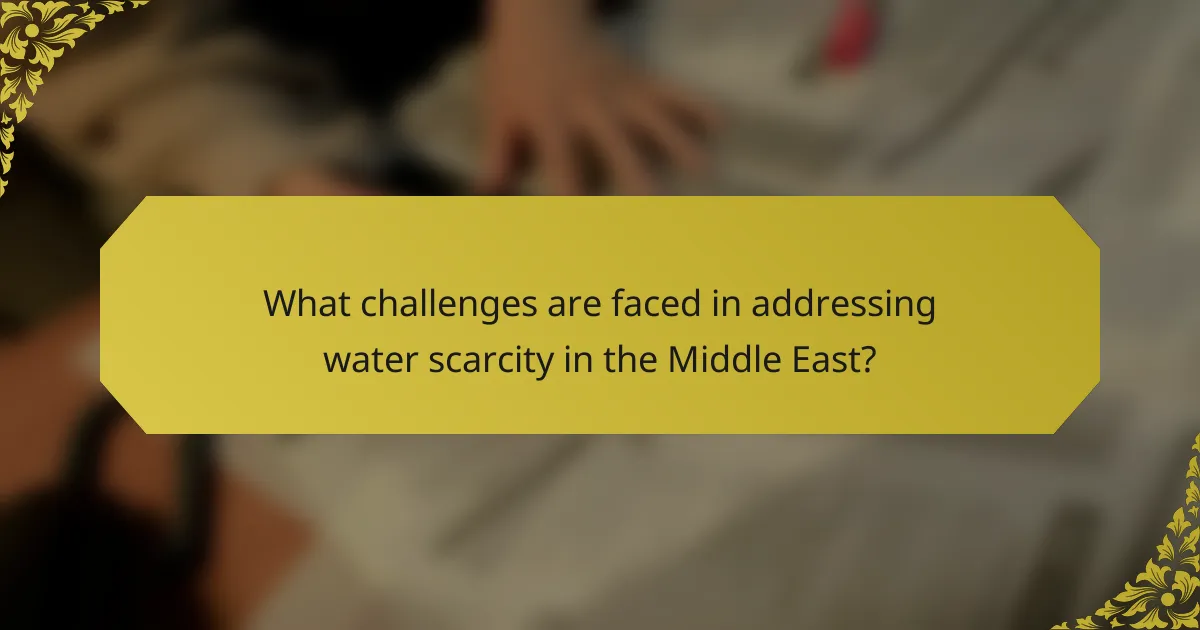
What challenges are faced in addressing water scarcity in the Middle East?
Water scarcity in the Middle East is primarily challenged by limited freshwater resources. The region has some of the lowest levels of renewable water resources per capita globally. Climate change exacerbates these issues, leading to increased temperatures and reduced rainfall. Over-extraction of groundwater is common, depleting aquifers faster than they can recharge. Political conflicts often hinder cooperative water management and infrastructure development. Additionally, population growth increases demand for water, straining existing supplies. Agricultural practices contribute to water wastage, as irrigation efficiency is often low. These challenges collectively complicate efforts to address water scarcity effectively in the region.
What political factors hinder effective water management?
Political factors that hinder effective water management include lack of cooperation between countries, political instability, and inadequate governance. Countries in the Middle East often share water resources, leading to disputes and conflicts over access and rights. Political instability can disrupt water management initiatives and investments. Additionally, inadequate governance leads to inefficient allocation and management of water resources. A report by the World Bank indicates that transboundary water disputes can escalate tensions, impacting regional stability. Effective water management requires collaboration, which is often stifled by these political barriers.
How do regional conflicts influence water resource distribution?
Regional conflicts significantly influence water resource distribution by exacerbating competition for limited water supplies. In the Middle East, countries often share transboundary water sources, such as rivers and aquifers. Conflicts can lead to the militarization of water access, impacting both availability and quality. For example, the Tigris and Euphrates rivers are vital for Iraq and Turkey. Disputes over dam constructions by Turkey have affected water flow to Iraq. Additionally, the ongoing Israeli-Palestinian conflict has resulted in unequal access to aquifers in the West Bank. Water scarcity is further intensified by political tensions, leading to unsustainable extraction practices. Historical agreements often become void during conflicts, complicating negotiations for equitable distribution. The result is a cycle of tension that hampers cooperative water management efforts essential for regional stability.
What are the challenges of international water treaties in the Middle East?
International water treaties in the Middle East face several challenges. Conflicting national interests complicate negotiations. Countries often prioritize their own water security over cooperative agreements. Historical grievances also hinder trust among nations. Limited water resources intensify competition for access. Political instability in the region further disrupts dialogue. Legal frameworks are often weak or poorly enforced. Climate change exacerbates water scarcity, making treaties more urgent yet harder to negotiate. These factors collectively impede effective international cooperation on water management.
What technological and infrastructural issues complicate water access?
Technological and infrastructural issues complicate water access significantly. Aging water infrastructure leads to leaks and inefficiencies. Many regions lack modern treatment facilities, reducing water quality. Limited investment in technology hampers water management systems. Inefficient irrigation practices waste large amounts of water. Geographic disparities create challenges in water distribution. Political conflicts can disrupt water supply systems. Climate change exacerbates existing infrastructural vulnerabilities. These factors collectively hinder equitable access to water resources.
How does outdated infrastructure contribute to water loss?
Outdated infrastructure significantly contributes to water loss through leaks and inefficiencies. Aging pipes often develop cracks and holes, allowing water to escape before reaching consumers. According to the American Society of Civil Engineers, over 6 billion gallons of treated water are lost daily in the U.S. alone due to such leaks. Additionally, outdated treatment facilities may not operate at optimal efficiency, leading to further water wastage. In the Middle East, where water is scarce, this inefficiency exacerbates the existing water scarcity issues. Upgrading infrastructure can reduce these losses and improve overall water management.
What technological advancements are needed to improve water management?
Innovative water management requires advancements in smart irrigation systems. These systems utilize sensors to optimize water usage based on real-time data. Remote sensing technology can monitor water resources and predict shortages. Advanced filtration and desalination technologies are essential for converting seawater into potable water. IoT devices can facilitate efficient water distribution and leak detection. Data analytics can enhance decision-making by forecasting water demand. Renewable energy integration can power water management systems sustainably. These advancements collectively address the pressing challenges of water scarcity in the Middle East.

What solutions are being proposed to combat water scarcity?
Proposed solutions to combat water scarcity include improved water management practices. These practices focus on efficient irrigation techniques and rainwater harvesting. Desalination technology is also being advanced to convert seawater into potable water. Water recycling and reuse initiatives are gaining traction in urban areas. Policies promoting sustainable water usage are being implemented at governmental levels. Education on water conservation is being prioritized in communities. International cooperation on transboundary water resources is being encouraged. Investments in infrastructure for better water distribution are being planned.
How can sustainable practices improve water conservation?
Sustainable practices improve water conservation by promoting efficient water use and reducing waste. Techniques such as drip irrigation allow farmers to deliver water directly to plant roots. This method can reduce water usage by up to 60% compared to traditional irrigation. Rainwater harvesting systems capture and store rain for later use, decreasing reliance on groundwater. Implementing xeriscaping involves using drought-resistant plants, minimizing the need for irrigation. According to the Food and Agriculture Organization, sustainable agricultural practices can enhance water efficiency by 20-50%. These methods collectively contribute to maintaining water resources in water-scarce regions like the Middle East.
What role do desalination technologies play in addressing water scarcity?
Desalination technologies play a crucial role in addressing water scarcity by converting seawater into potable water. These technologies provide an alternative water source in arid regions, particularly in the Middle East. Countries like Saudi Arabia and the UAE rely heavily on desalination to meet their water needs. Desalination can produce millions of cubic meters of fresh water daily. For instance, the Ras Al Khair plant in Saudi Arabia has a capacity of 1.025 million cubic meters per day. This technology helps mitigate the impact of dwindling freshwater resources. Additionally, it supports agricultural and industrial activities in water-scarce areas. Desalination technologies are essential for ensuring water security in regions facing severe water shortages.
How can rainwater harvesting contribute to local water supplies?
Rainwater harvesting can significantly enhance local water supplies. It involves collecting and storing rainwater for various uses. This practice reduces dependence on conventional water sources. In arid regions, like the Middle East, it helps mitigate water scarcity. Studies show that rainwater harvesting can provide up to 50% of a household’s water needs in some areas. It also decreases runoff and erosion, improving soil health. Furthermore, it can recharge groundwater aquifers, promoting sustainable water management. Implementing rainwater harvesting systems can lead to more resilient local water supplies.
What policies can governments implement to manage water resources effectively?
Governments can implement various policies to manage water resources effectively. These include establishing water allocation regulations to ensure equitable distribution. They can also promote water conservation practices among industries and households. Investment in modern irrigation techniques can enhance agricultural efficiency. Governments may create incentives for rainwater harvesting systems. Implementing strict pollution control measures protects water quality. Establishing transboundary water agreements fosters regional cooperation. Finally, public awareness campaigns encourage responsible water usage. These policies are crucial for addressing water scarcity, especially in the Middle East.
How can regional cooperation enhance water sharing agreements?
Regional cooperation can enhance water sharing agreements by fostering trust and collaboration among neighboring countries. When nations work together, they can identify shared water resources and establish equitable distribution methods. Collaborative frameworks can lead to joint management of water basins, reducing conflicts over water rights. Regional partnerships can also facilitate the sharing of best practices and technologies for water conservation. Studies show that countries engaged in cooperative agreements are more likely to achieve sustainable water management, as seen in the successful examples of the Jordan River basin. Furthermore, cooperative agreements can attract international support and funding, reinforcing the commitment to shared water resources.
What are the best practices for community engagement in water management?
Best practices for community engagement in water management include fostering inclusive participation, ensuring transparent communication, and building trust among stakeholders. Inclusive participation allows diverse community voices to contribute to decision-making. Transparent communication involves sharing information about water resources and management plans openly. Building trust is essential for effective collaboration and long-term commitment. Research indicates that communities involved in water management decisions are more likely to support sustainable practices. The World Bank emphasizes community engagement as a key factor in successful water management initiatives.
What practical steps can individuals take to conserve water?
Individuals can conserve water by implementing several practical steps. Fixing leaks is essential as a single drip can waste over 3,000 gallons annually. Taking shorter showers can save up to 5 gallons per minute. Installing low-flow fixtures reduces water usage without sacrificing performance. Collecting rainwater for gardening is an effective way to utilize natural resources. Running dishwashers and washing machines only with full loads maximizes efficiency. Using mulch in gardens retains moisture and reduces the need for watering. Adjusting sprinklers to avoid watering sidewalks and driveways can prevent unnecessary waste. These actions collectively contribute to significant water savings, especially in water-scarce regions like the Middle East.
Water scarcity in the Middle East is a critical issue driven by factors such as over-extraction of water resources, climate change, and population growth. The region faces some of the lowest freshwater availability per capita globally, with geographical features and climate conditions further exacerbating water scarcity. Key challenges include inefficient agricultural practices, political conflicts affecting water management, and outdated infrastructure. Proposed solutions encompass improved water management practices, technological advancements, and regional cooperation to enhance water sharing agreements. Addressing these issues is essential for ensuring water security and mitigating the social and economic implications of water scarcity in the region.
